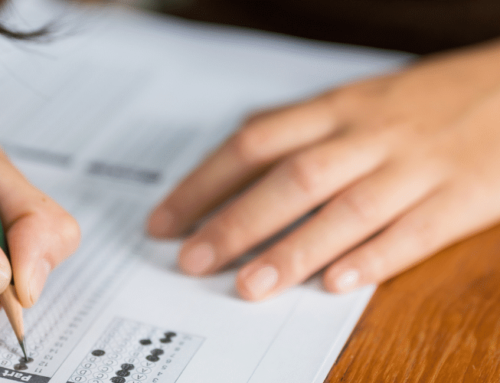It hasn’t been long since CollegeBoard Announced That the SAT is Going Digital. International students have already made the switch, but now it’s time for the US. As of January of 2024, all students will take the SAT digitally. There are several key differences between the old SAT and the new SAT, including shorter reading passages, adaptive questions, and fewer sections. In other words, the fact that the test is now digital isn’t the only change! While SAT test prep will largely remain the same, it’s important for students to understand the differences between the old SAT and the new SAT. After all, managing expectations is one of the most important steps for Preparing for SAT Test Day.
10 differences between the old and new SAT
There are lots of reasons why CollegeBoard decided to make the switch to a digital exam, including factors related to accessibility and relevance. After all, CollegeBoard wants the test to remain culturally relevant, especially as more colleges decide to go test-optional. But what do these changes look like in practice?
For more insights, review the 10 differences between the old and new SAT listed below:
The exam is digital

While the new SAT test is now offered online, it is not offered remotely. This means that students will still need to take their exam at an approved test site, such as at a local school. These test sites will have an IT technician on hand to help troubleshoot any technical difficulties.
The exam is digital.
The new digital SAT will be administered through a digital app called Bluebook. This means that students will need to take the exam on a device with a strong wifi connection. Students will have the option to use their own pre-approved device, such as a laptop and tablet, or borrow a device from their school or testing center. CollegeBoard will also have a loan program where students can borrow a device for the duration of their test.
While the new SAT test is now offered online, it is not offered remotely. This means that students will still need to take their exam at an approved test site, such as at a local school. These test sites will have an IT technician on hand to help troubleshoot any technical difficulties. 
The exam is an hour shorter
While the pencil-and-paper SAT lasted three hours, the new SAT only takes two hours and 14 minutes. Test-taking is always stressful and long exams can be draining — especially high-stakes exams like the SAT. Hopefully now that it’s an hour shorter, you’ll be able to stay focused throughout the exam.
The exam is an hour shorter.
While the pencil-and-paper SAT lasted three hours, the new SAT only takes two hours and 14 minutes. Test-taking is always stressful and long exams can be draining — especially high-stakes exams like the SAT. Hopefully now that it’s an hour shorter, you’ll be able to stay focused throughout the exam.
There are 2 test sections instead of 3
One of the reasons why the new SAT test is an hour shorter is because the exam now consists of two sections instead of three. Previously, the SAT had a Math section, a Reading section, and a Writing section. Now there are only two sections: a Math section and a Reading/Writing section.
Both the Math and Reading/Writing sections are broken down into two modules. For the Reading/Writing Modules, the Reading questions make up the first half of each module and the Writing questions make up the second half of each module. Students must complete Module 1 before they can move onto Module 2 on both the Math and Reading/Writing sections.
Now, let’s take a closer look at how the exams is organized:
There are 2 test sections instead of 3.
One of the reasons why the new SAT test is an hour shorter is because the exam now consists of two sections instead of three. Previously, the SAT had a Math section, a Reading section, and a Writing section. Now there are only two sections: a Math section and a Reading/Writing section.
Both the Math and Reading/Writing sections are broken down into two modules. For the Reading/Writing Modules, the Reading questions make up the first half of each module and the Writing questions make up the second half of each module. Students must complete Module 1 before they can move onto Module 2 on both the Math and Reading/Writing sections.
Now, let’s take a closer look at how the exams is organized:
Reading passages are shorter

Reading passages are shorter.
The old SAT featured both long and short reading passages, with passages ranging from 500-750 words. These passages corresponded with sets of multiple questions. The new SAT, however, features shorter reading passages, with passages ranging from 25-150 words. Each passage only corresponds to one question. Overall, the questions — on both the Math and Reading/Writing sections — are more straightforward. 
Students have access to digital tools
The new SAT format features several digital tools, including a countdown clock, a way to flag questions and come back to them, a digital reference sheet for the Math section, and a built-in graphing calculator. It’s worth noting that for the new SAT test students can use the built-in graphing calculator on all Math questions.
Students have access to digital tools.
The new SAT format features several digital tools, including a countdown clock, a way to flag questions and come back to them, a digital reference sheet for the Math section, and a built-in graphing calculator. It’s worth noting that for the new SAT test students can use the built-in graphing calculator on all Math questions.
The test questions are adaptive
The new SAT generates individualized exams, based on the questions each test-taker gets right and wrong. All sections contain a mix of easy, medium, and difficult questions. And how well you perform on the first module of each section determines the difficulty of the second module.
While the old SAT scored all questions equally, regardless of difficulty, the new SAT format gives weighted scores. This means that answering a difficult question correctly will count more than answering an easy question correctly. Depending on how well you did on module 1, you’ll receive a slightly-easier or slightly-more-difficult version of module 2.
The test questions are adaptive.
The new SAT generates individualized exams, based on the questions each test-taker gets right and wrong. All sections contain a mix of easy, medium, and difficult questions. And how well you perform on the first module of each section determines the difficulty of the second module.
While the old SAT scored all questions equally, regardless of difficulty, the new SAT format gives weighted scores. This means that answering a difficult question correctly will count more than answering an easy question correctly. Depending on how well you did on module 1, you’ll receive a slightly-easier or slightly-more-difficult version of module 2.
Scores are calculated according to an algorithm
Given the nature of the new SAT format, scores can no longer be calculated by a simple right to wrong ratio. Rather, the SAT is now scored according to an algorithm. This algorithm takes the difficulty of each question into account. If you are aiming for a top score, you’ll need to do as well as possible on the first modules, so that you’ll be given the more advanced module 2 — and thus have the potential of earning a higher score on the overall exam.
Scores are calculated according to an algorithm.
Given the nature of the new SAT format, scores can no longer be calculated by a simple right to wrong ratio. Rather, the SAT is now scored according to an algorithm. This algorithm takes the difficulty of each question into account. If you are aiming for a top score, you’ll need to do as well as possible on the first modules, so that you’ll be given the more advanced module 2 — and thus have the potential of earning a higher score on the overall exam.
Score reports are available sooner

Score reports are available sooner.
Rather than having to wait weeks for your score report, you’ll receive your results much more quickly. Most likely within a couple of days! This will help you make decisions about retakes and score reports more quickly. Students will also have the option to retake the SAT closer to their college application deadlines, in case they want to try for their dream score one last time.
Students will receive more college and career guidance
Upon receiving their official score reports, students will also receive more personalized college and career guidance. Personalized recommendations will include information about 4-year colleges, local 2-year colleges, workforce training programs, and insight into how their test scores may be reflective of potential career paths.
Students will receive more college and career guidance.
Upon receiving their official score reports, students will also receive more personalized college and career guidance. Personalized recommendations will include information about 4-year colleges, local 2-year colleges, workforce training programs, and insight into how their test scores may be reflective of potential career paths.
Students will have access to official digital practice exams
Through the Bluebook app, students will be able to take full-length digital practice exams. Like the actual exam, these practice exams will feature adaptive questions. This means that you’ll get more individualized practice exams.
Students will have access to official digital practice exams.
Through the Bluebook app, students will be able to take full-length digital practice exams. Like the actual exam, these practice exams will feature adaptive questions. This means that you’ll get more individualized practice exams.
So what’s staying the same?
The new SAT has a lot of changes, but some things are staying the same. Most importantly, in order to get the best score possible, you’ll need to commit to an SAT study plan. Check out these SAT study plans and schedule templates to help you plan accordingly.
In addition to taking digital practice exams through the Bluebook app, you’ll also want to refer to an SAT test prep book. While you’ll no longer be taking a paper-and-pencil version of the exam, the SAT test prep books will give you in-depth explanations of key concepts you’ll need in order to be successful on the exam. And if you’re looking for even more study resources, check out this list of the best SAT prep websites.
Feeling ready to take the new SAT test? Check out the SAT and ACT Test Dates for 2023-24 and start studying!
So what’s staying the same?

In addition to taking digital practice exams through the Bluebook app, you’ll also want to refer to an SAT test prep book. While you’ll no longer be taking a paper-and-pencil version of the exam, the SAT test prep books will give you in-depth explanations of key concepts you’ll need in order to be successful on the exam. And if you’re looking for even more study resources, check out this list of the best SAT prep websites.
Feeling ready to take the new SAT test? Check out the SAT and ACT Test Dates for 2023-24 and start studying!
Subscribe to our blog
Don’t miss out on the latest college admissions trends, updates, and tips!



